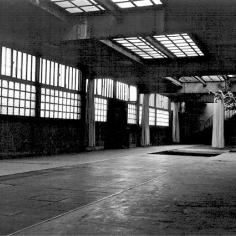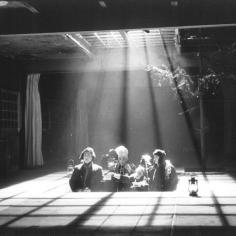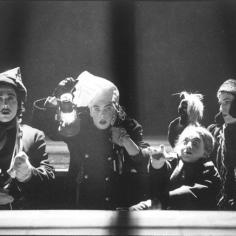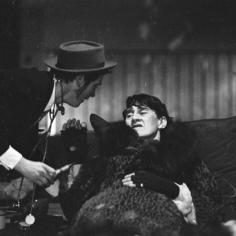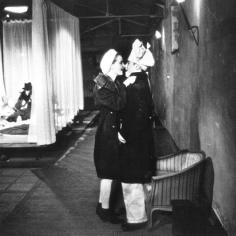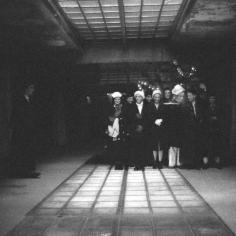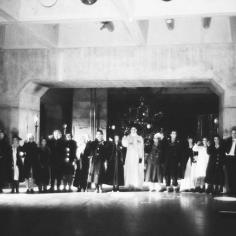1991 · La Maison d’Os · (House of Bones) · Dubillard · Vigner (EN)
"It is better to say what you want than what you’re expected to say, or else I’ll keep quiet. The choice is yours ." [1]
Eric Vigner chose LA MAISON D'OS by ROLAND DUBILLARD as the first production of his theater company COMPAGNIE SUZANNE M. This first play was to be the ‘manifesto’ of his artistic, aesthetic and moral determination to bring to life, here and now, a free theatre, a theatre free from ideological ways and byways, a far cry from the triumph of the pretences of a theatre bogged down by false compromises.
LA MAISON D'OS was first staged in 1962, directed by Arlette Reinerg, at the Théâtre de Lutèce, a small theatre that has since been closed down, and it was not restaged until 1991, when ERIC VIGNER got hold of it and embarked on the venture along with some twenty or so young actors (ODILE BOUGEARD, ÉLSA BOUCHAIN, BRUNO BOULZAGUET, CHRISTOPHE BRAULT, ARNAUD CHURIN, PHILIPPE COTTEN, MYRIAM COURCHELLE, BENOÎT DI MARCO, BENOÎT GIROS, XAVIER DE GUILLEBON, PAULINE HEMSI, PASCAL LACROIX, DENIS LÉGER-MILHAU, GAËL LESCOT, LAURENT LÉVY, FRANÇOIS MOREL, ARTHUR NAUZYCIEL, JEAN-FRANÇOIS PERRIER, GUILLAUME RANNOU, ALICE VARENNE, KARINE VUILLERMOZ, CATHERINE VUILLEZ). By inviting subscriptions, he succeeded in putting on this play, the first with his company, in an unlikely setting - an abandoned factory in Issy-les-Moulineaux, where it opened on 25 January 1991.
"A narrow three-storied building: DUBILLARD’s ‘vertical space’. Actually, an ancient mattress factory; once you enter the ground floor with the stage, you can read - or rather, guess - words written on the wall with its peeling plaster: ‘hairs’, ‘feathers’… The first encounter with this place was extraordinary - a magic place, it met all that DUBILLARD had wished and dreamt of: his entire play relies on verticality, not horizontality. What I wanted was to make the audience part of the house. All too often, in the theatre, the audience is placed in front of things, outside the action. I wanted to make sure they were ‘in’ it, part of it - that’s what the play is all about. A crazy stage for an insane spectacle which, even though it does not take the spectator from the basement to the loft, will nevertheless ‘transport’ him (in the original sense of the term) from one level of the stage to another."
ÉRIC VIGNER
Thursday 6 May
"There’s nothing like Paris as regards its bourgeois tragedies. These days Mme X departed this life, one week after her husband. The House of X –with a capital of unknown proportions, sported horses and carriages and employed numerous servants. Madame died in her bed; she had not been undressed, for five days, by her chambermaids, because these were engaged in an orgy with the male servants in the basement; and the mustard plasters recommended by her physician had been applied, by her drunken coachman, on her stockings, yes, on her stockings which had not been taken off." Inspired by this notice in the Journal des Goncourt (1880), the subject of LA MAISON D'OS is the agony of a very rich old man without a family but with some forty servants about him who couldn’t have cared less. The play (comedy or tragedy?) does not give the impression of an artificial ‘construct’. In reality, it is constructed like a house. That is to say, it is devoid of movement; it is not constructed to have a temporal dimension, like a symphony or drama. If it has some duration, it is because everything takes time (looking at a painting, visiting ruins…). The action (or lack thereof) takes place in a ramshackle, abandoned house, abandoned as its inhabitants abandon one another; life takes place, first and foremost, in vertical space – from the cellar to the loft. The relations between the master and his subordinates (including physicians, clergymen or lawyers), among the servants, between the protagonist and himself and death, and lastly between the stones and beams of the house – these relations are sufficiently diverse and numerous to suggest some sort of movement in this inert structure, this dead building, just as a carcass seems to be alive as it crawls with maggots. The subject is in no way more macabre than quite a few classical works. Still, LA MAISON D'OS is open to the meaning of life, and even to its comical aspects. The author insists he has not hidden any sort of philosophy in it."
Roland Dubillard, 1962
THE MAID: What do you want ?
The valet does not reply.
Oh !... How old are you ? (no answer)
But for heaven’s sake, what’s the matter with you ? What are you here, what ? What are you, in this box ? Tell me! How much does Monsieur pay you ? You’re nothing, but nothing !
THE VALET : And you ? [1]
Eric Vigner’s production of the play shows his outstanding skills as an illusionist and ‘handler’ of space, his ability to adapt and invent things to subserve a rare piece of writing about the ‘without’ and ‘within’ of buildings and human beings, the nostalgia of childhood, human and animal anguish, a veritable exploration of ‘the space within’, as Henri Michaux put it. LA MAISON D'OS is a considerable success and is re-staged, six months later, in the course of the Paris Autumn Festival 1991 in the depths of the Grande Arche de la Défense.
"At Issy, the leprous walls and the winter cold turned DUBILLARD’s world into a narrow, closed-in-itself universe and conjured up a late 19th century end-of-the-world atmosphere. At La Défense, where all is clean and open, the end of the world is the end of our century. Where there were stones at Issy there is water at La Défense. The MAISON D'OS is NOAH’s Ark. The spectators are slightly askew, as on a sinking ship that lists as it goes down. It’s all a matter of space.”
ÉV
Excerpts translated from the French by HERBERT KAISER
© Photography : Alain Fonteray
Texts assembled by Jutta Johanna Weiss
Translation from the French by Herbert Kaiser

